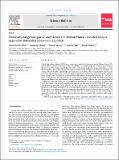Potentially dangerous glacial lakes across the Tibetan Plateau revealed using a large-scale automated assessment approach
Date
15/04/2019Metadata
Show full item recordAbstract
Glacial lake outburst floods (GLOFs) are a major concern in the Himalaya and on the Tibetan Plateau (TP), where several disasters occurring over the past century have caused significant loss of life and damage to infrastructure. This study responds directly to the needs of local authorities to provide guidance on the most dangerous glacial lakes across TP where local monitoring and other risk reduction strategies can subsequently be targeted. Specifically, the study aims to establish a first comprehensive prioritisation ranking of lake danger for TP, considering both the likelihood and possible magnitude of any outburst event (hazard), and the exposure of downstream communities. A composite inventory of 1291 glacial lakes (>0.1 km2 ) was derived from recent remote sensing studies, and a fully automated and object assessment scheme was implemented using customised GIS tools. Based on four core determinates of GLOF hazard (lake size, watershed area, topographic potential for ice/rock avalanching, and dam steepness), the scheme accurately distinguishes the high to very high hazard level of 19 out of 20 lakes that have previously generated GLOFs. Notably, 16% of all glacial lakes threaten human settlements, with a hotspot of GLOF danger identified in the central Himalayan counties of Jilong, Nyalam, and Dingri, where the potential trans-boundary threat to communities located downstream in Nepal is also recognised. The results provide an important and object scientific basis for decision-making, and the methodological approach is ideally suited for replication across other mountainous regions where such first-order studies are lacking.
Citation
Allen , S K , Zhang , G , Wang , W , Yao , T & Bolch , T 2019 , ' Potentially dangerous glacial lakes across the Tibetan Plateau revealed using a large-scale automated assessment approach ' , Science Bulletin , vol. 64 , no. 7 , pp. 435-445 . https://doi.org/10.1016/j.scib.2019.03.011
Publication
Science Bulletin
Status
Peer reviewed
ISSN
2095-9273Type
Journal article
Description
The study was supported by the project “Recent and future EVOlution of Glacial LAkes in China (EVOGLAC): Spatio-temporal diversity and hazard potential” funded by the Swiss National Science Foundation (No. IZLCZ2_169979/1) add counterpart grant of the Natural Science Foundation of China (No. 21661132003). The project further benefited from support of the Strategic Priority Research Program (A) of the Chinese Academy of Sciences (No. XDA20060201) and collaboration within the Dragon 4 project funded by the European Space Agency (No. 4000121469/17/I-NB).Collections
Items in the St Andrews Research Repository are protected by copyright, with all rights reserved, unless otherwise indicated.

